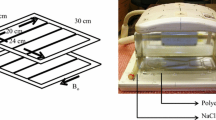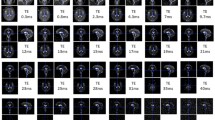Abstract
Introduction
Although relevant for assessment of sodium in multiple endocrine pathways, 23Na-T1 quantification is challenging due to technical limitations (SAR, B1 inhomogeneity) or influence of tissue’s local molecular dynamics. Hereby, we propose T1 quantification of 23Na-MRI signal acquired over the abdomen using a centric-reordered saturation-recovery (SR) true fast imaging with steady state precession (TrueFISP) sequence.
Materials and methods
Measurements were performed at 3T using a dual-tunable 23Na/1H coil in 7 healthy volunteers (TR/TE = 858–928/1.57 ms; flip angle = 90°; bandwidth = 450 Hz/px; voxel size = 5 × 5 × 10 mm3). Variable T1-weighting was achieved applying non-selective saturation pre-pulses delayed from the centre of the k-space acquisition by 25, 40, 60, 120 and 250 ms. T1-curve fitting was performed slice-wise, separately for average intensity values from the manually segmented areas of the renal parenchyma and spinal canal, over the increasing SR times- assuming monoexponential signal pattern.
Results
Mean ± standard deviation of 23Na-T1 was found as 29 ± 10 ms and 35 ± 8 ms for the renal parenchyma and the spinal canal, respectively.
Discussion
23Na-T1 quantification using a SR-TrueFISP is feasible in clinical settings, in the images constrained by clinically applicable acquisition time of reduced spatial resolution or averages.



Similar content being viewed by others
References
Kaniusas E (2012) Physiological and functional basis. Biomedical signals and sensors I: linking physiological phenomena and biosignals. Springer, Heidelberg, pp 27–181
Kulbacka J, Choromanska A, Rossowska J, Wezgowiec J, Saczko J, Rols MP (2017) Cell membrane transport mechanisms: ion channels and electrical properties of cell membranes. Adv Anat Embryol Cell Biol 227:39–58
Patel S, Rauf A, Khan H, Abu-Izneid T (2017) Renin–angiotensin–aldosterone (RAAS): the ubiquitous system for homeostasis and pathologies. Biomed Pharmacother 94:317–325
Peters J (2012) Local renin-angiotensin systems in the adrenal gland. Peptides 34(2):427–432
Madelin G, Regatte RR (2013) Biomedical applications of sodium MRI in vivo. J Magn Reson Imaging 38(3):511–529
Thulborn KR (2018) Quantitative sodium MR imaging: A review of its evolving role in medicine. Neuroimage 168:250–268
Bottomley PA (2012) Sodium MRI in man: technique and findings. In: Harris RK, Wasylishen RE (eds) Encyclopedia of magnetic resonance (eMagRes), vol 1. Wiley, Chichester, pp 353–366
Ra JB, Hilal SK, Oh CH, Mun IK (1988) In vivo magnetic resonance imaging of sodium in the human body. Magn Reson Med 7(1):11–22
Granot J (1988) Sodium imaging of human body organs and extremities in vivo. Radiology 167(2):547–550
Steidle G, Graf H, Schick F (2004) Sodium 3-D MRI of the human torso using a volume coil. Magn Reson Imaging 22(2):171–180
Maril N, Rosen Y, Reynolds GH, Ivanishev A, Ngo L, Lenkinski RE (2006) Sodium MRI of the human kidney at 3 Tesla. Magn Reson Med 56(6):1229–1234
Shah NJ, Worthoff WA, Langen KJ (2016) Imaging of sodium in the brain: a brief review. NMR Biomed 29(2):162–174
Zollner FG, Konstandin S, Lommen J, Budjan J, Schoenberg SO, Schad LR, Haneder S (2016) Quantitative sodium MRI of kidney. NMR Biomed 29(2):197–205
Haneder S, Konstandin S, Morelli JN, Nagel AM, Zoellner FG, Schad LR, Schoenberg SO, Michaely HJ (2011) Quantitative and qualitative (23)Na MR imaging of the human kidneys at 3 T: before and after a water load. Radiology 260(3):857–865
Civan MM, Shporer M (1978) NMR of sodium-23 and potassium-39 in biological systems. In: Berliner LJ, Reuben J (eds) Biological magnetic resonance. Springer, Boston pp 1–32
Hubbard PS (1970) Nonexponential nuclear magnetic relaxation by quadrupole interactions. J Chem Phys 53(3):985–987
Woessner DE (2001) NMR relaxation of spin-3/2 nuclei: effects of structure, order, and dynamics in aqueous heterogeneous systems. Concepts Magn Reson 13 (5):294-325.
Shinar H, Navon G (1984) NMR relaxation studies of intracellular Na+ in red blood cells. Biophys Chem 20(4):275–283
Ridley B, Nagel AM, Bydder M, Maarouf A, Stellmann JP, Gherib S, Verneuil J, Viout P, Guye M, Ranjeva JP, Zaaraoui W (2018) Distribution of brain sodium long and short relaxation times and concentrations: a multi-echo ultra-high field (23)Na MRI study. Sci Rep 8(1):4357
Fleysher L, Oesingmann N, Brown R, Sodickson DK, Wiggins GC, Inglese M (2013) Noninvasive quantification of intracellular sodium in human brain using ultrahigh-field MRI. NMR Biomed 26(1):9–19
Atthe BK, Babsky AM, Hopewell PN, Phillips CL, Molitoris BA, Bansal N (2009) Early monitoring of acute tubular necrosis in the rat kidney by 23Na-MRI. Am J Physiol Renal Physiol 297(5):F1288–F1298
Bansal N, Germann MJ, Seshan V, Shires GT 3rd, Malloy CR, Sherry AD (1993) Thulium 1,4,7,10-tetraazacyclododecane-1,4,7,10-tetrakis(methylene phosphonate) as a 23Na shift reagent for the in vivo rat liver. Biochemistry 32(21):5638–5643
Burstein D, Fossel ET (1987) Intracellular sodium and lithium NMR relaxation times in the perfused frog heart. Magn Reson Med 4(3):261–273
Banni S, Casu M, Corongiu FP, Dessi MA, Lai A, Meloni C (1987) NMR spin-lattice relaxation times of intracellular Na-23 on rat livers and related lipid peroxidation following CCl4 intoxication. Chem Biol Interact 63(3):207–214
Nagel AM, Amarteifio E, Lehmann-Horn F, Jurkat-Rott K, Semmler W, Schad LR, Weber MA (2011) 3 Tesla sodium inversion recovery magnetic resonance imaging allows for improved visualization of intracellular sodium content changes in muscular channelopathies. Invest Radiol 46(12):759–766
Stobbe R, Beaulieu C (2005) In vivo sodium magnetic resonance imaging of the human brain using soft inversion recovery fluid attenuation. Magn Reson Med 54(5):1305–1310
Burstein D, Springer CS Jr (2019) Sodium MRI revisited. Magn Reson Med 82(2):521–524
Scheffler K, Hennig J (2001) T(1) quantification with inversion recovery TrueFISP. Magn Reson Med 45(4):720–723
Yushkevich PA, Piven J, Hazlett HC, Smith RG, Ho S, Gee JC, Gerig G (2006) User-guided 3D active contour segmentation of anatomical structures: significantly improved efficiency and reliability. Neuroimage 31(3):1116–1128
Gonzalez RC, Woods RE (2018) Digital image processing, fourth edn. Pearson, New York
Casu M, Corongiu FP, Dessi MA, Frau M, Lai A (1986) Na-23 NMR spin-lattice relaxation times in rat tissues, and related modifications following CCl4 intoxication. Biochem Biophys Res Commun 134(3):1079–1085
Maril N, Margalit R, Mispelter J, Degani H (2004) Functional sodium magnetic resonance imaging of the intact rat kidney. Kidney Int 65(3):927–935
Wolff SD, Eng J, Berkowitz BA, James S, Balaban RS (1990) Sodium-23 nuclear magnetic resonance imaging of the rabbit kidney in vivo. Am J Physiol 258(4 Pt 2):F1125–F1131
Solanky BS, Riemer F, Golay X, Wheeler-Kingshott CA (2013) Sodium quantification in the spinal cord at 3T. Magn Reson Med 69(5):1201–1208
Coste A, Boumezbeur F, Vignaud A, Madelin G, Reetz K, Le Bihan D, Rabrait-Lerman C, Romanzetti S (2019) Tissue sodium concentration and sodium T1 mapping of the human brain at 3T using a Variable Flip Angle method. Magn Reson Imaging 58:116–124
Leroi L, Coste A, de Rochefort L, Santin MD, Valabregue R, Mauconduit F, Giacomini E, Luong M, Chazel E, Valette J, Le Bihan D, Poupon C, Boumezbeur F, Rabrait-Lerman C, Vignaud A (2018) Simultaneous multi-parametric mapping of total sodium concentration, T1, T2 and ADC at 7 T using a multi-contrast unbalanced SSFP. Magn Reson Imaging 53:156–163
Constantinides CD, Gillen JS, Boada FE, Pomper MG, Bottomley PA (2000) Human skeletal muscle: sodium MR imaging and quantification—potential applications in exercise and disease. Radiology 216(2):559–568
Navon G, Shinar H, Eliav U, Seo Y (2001) Multiquantum filters and order in tissues. NMR Biomed 14(2):112–132
Petracca M, Vancea RO, Fleysher L, Jonkman LE, Oesingmann N, Inglese M (2016) Brain intra- and extracellular sodium concentration in multiple sclerosis: a 7 T MRI study. Brain 139(Pt 3):795–806
Inglese M, Oesingmann N, Zaaraoui W, Ranjeva JP, Fleysher L (2013) Sodium imaging as a marker of tissue injury in patients with multiple sclerosis. Multiple Sclerosis Relat Disord 2(4):263–269
Bouhrara M, Reiter DA, Celik H, Bonny JM, Lukas V, Fishbein KW, Spencer RG (2015) Incorporation of Rician noise in the analysis of biexponential transverse relaxation in cartilage using a multiple gradient echo sequence at 3 and 7 Tesla. Magn Reson Med 73(1):352–366
Paschke NK, Neumann W, Uhrig T, Winkler M, Neumaier-Probst E, Fatar M, Schad LR, Zollner FG (2018) Influence of gadolinium-based contrast agents on tissue sodium quantification in sodium magnetic resonance imaging. Invest Radiol 53(9):555–562
Schmitt P, Griswold MA, Jakob PM, Kotas M, Gulani V, Flentje M, Haase A (2004) Inversion recovery TrueFISP: quantification of T(1), T(2), and spin density. Magn Reson Med 51(4):661–667
Gudbjartsson H, Patz S (1995) The Rician distribution of noisy MRI data. Magn Reson Med 34(6):910–914
Nagel AM, Laun FB, Weber MA, Matthies C, Semmler W, Schad LR (2009) Sodium MRI using a density-adapted 3D radial acquisition technique. Magn Reson Med 62(6):1565–1573
Lommen J, Konstandin S, Kramer P, Schad LR (2016) Enhancing the quantification of tissue sodium content by MRI: time-efficient sodium B1 mapping at clinical field strengths. NMR Biomed 29(2):129–136
Gast LV, Gerhalter T, Hensel B, Uder M, Nagel AM (2018) Double quantum filtered (23) Na MRI with magic angle excitation of human skeletal muscle in the presence of B0 and B1 inhomogeneities. NMR Biomed 31(12):e4010
Stobbe RW, Beaulieu C (2014) Exploring and enhancing relaxation-based sodium MRI contrast. MAGMA 27(1):21–33
Kline RP, Wu EX, Petrylak DP, Szabolcs M, Alderson PO, Weisfeldt ML, Cannon P, Katz J (2000) Rapid in vivo monitoring of chemotherapeutic response using weighted sodium magnetic resonance imaging. Clin Cancer Res 6(6):2146–2156
Decker CM, Zollner FG, Konstandin S, Schad LR (2012) Comparing anisotropic diffusion filters for the enhancement of sodium magnetic resonance images. Magn Reson Imaging 30(8):1192–1200
Acknowledgements
We would like to thank Dr. Markus Klarhoefer from Siemens Healthcare AG for his support during protocol optimization. We are also grateful to Dr. Anton S. Becker and to Prof. Dr. Andreas Boss for the application for ethical approval.
Funding
This work was supported by the Clinical Research Priority Program of the University of Zurich for the CRPP Hypertension Research Network (HYRENE).
Author information
Authors and Affiliations
Contributions
RSG—study design, acquisition of data, analysis and interpretation of data, drafting and revision of manuscript;AC—study design, critical revision;AM—study design, critical revision;CR—study conception and design, acquisition of data, drafting of manuscript, critical revision.
Corresponding author
Ethics declarations
Conflict of interest
Authors declare no conflict of interest during research, preparation and submission of current paper.
Additional information
Publisher's Note
Springer Nature remains neutral with regard to jurisdictional claims in published maps and institutional affiliations.
Rights and permissions
About this article
Cite this article
Gomolka, R.S., Ciritsis, A., Meier, A. et al. Quantification of sodium T1 in abdominal tissues at 3 T. Magn Reson Mater Phy 33, 439–446 (2020). https://doi.org/10.1007/s10334-019-00786-8
Received:
Revised:
Accepted:
Published:
Issue Date:
DOI: https://doi.org/10.1007/s10334-019-00786-8




